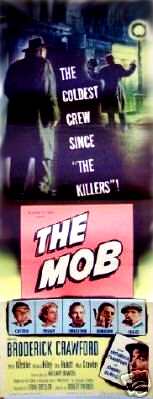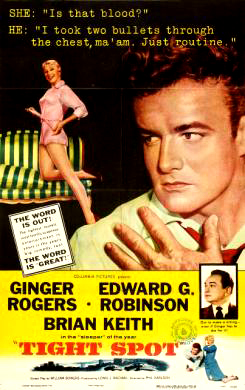
 |
|
|
|
How times change -- in the disc business 2011 will go down as the year that every studio (save for Warners?) licensed out its library titles for release. The TCM Vault Collection began by offering titles mostly from Universal and in the last year has branched out. After two successful noir packages, Columbia Pictures Film Noir Classics III is now a TCM release. The selection in this go-round contains one bona fide classic, three solid action thrillers and a late entry that's quite a chore to get through but may appeal to fans of its star. As is usual with Columbia/Sony product, the transfers are ultra clean and razor-sharp -- up-rezzed on a Hi Def TV, these mostly late-era noir shows look and sound terrific. 
The earliest film is the big winner. Director Joseph H. Lewis had been toiling for ten years on efficient but nondescript westerns when the sleeper hit My Name is Julia Ross put him on the map. The timing was perfect: with the war just finished the studios were looking for new creative blood. The story is an adapted women's film given a baroque noir twist. Julia Ross, an attractive secretary badly in need of a job (Nina Foch) responds to a want ad and wakes up in a mansion overlooking a Cornwall beach. She's told that she's Marian Hughes, the wife of Ralph Hughes (George Macready) and that she's just been released from an asylum. Unable to escape, Julia only slowly learns of her role in a fantastic, diabolical plot to secure a family inheritance. Although the story idea has been revisited many times since, My Name is Julia Ross still carries a major suspense kick. Julia tries various ruses to get a message out to her boyfriend in London. Ralph and his mother (Dame May Whitty) contrive to nullify her efforts by even more elaborate games playing. Director Lewis plays various POV gambits with his camera, although never as crudely as does William Castle in his imitation Hitchcock thriller When Strangers Marry. He conveys Julia's panic, claustrophobia and eventual determination to prevail over what shapes up to be a cold-blooded murder conspiracy. Joseph H. Lewis worked almost exclusively in film noir for the next ten years, directing the classic Gun Crazy and earning the respect of the entire industry. 
The entertaining organized crime thriller The Mob is noir only by the implication that rampant corruption lurks beneath many large industries. Stars Broderick Crawford and Richard Kiley are undercover cops who join a gang running the docks, and the story charts their efforts to avoid exposure and to learn the identity of the unknown Mr. Big in charge. Although filmed partly on location by the sometimes sublime director Robert Parrish (The Purple Plain, The Wonderful Country), The Mob can boast some very atmospheric studio scenes, especially an opening murder in the rain. As the stock story doesn't provide many surprises, the film's emphasis falls on its interesting characterizations. The roster of rough-tough hoods includes Ernest Borgnine & Neville Brand, with Don Megowan, John Marley and Charles Bronson in smaller parts). That guarantees a wide range of sadistic villainy, but the good-guys are almost as crude and violent. Star Crawford demonstrates his skill with bigger-than-life, slightly vulgar characters while the cultured Richard Kiley doesn't quite convince as a beer drinking bowling-night type. But the set-ups, rub-outs and confrontations supply plenty of desired mobster action. The surprise title of the set is Drive a Crooked Road, which shows a number of talents at their best. Director Richard Quine works very well with his actors and a script by Blake Edwards, and star Mickey Rooney proves that he can carry a low-key crime picture as brilliantly as he did his old MGM musicals. The use of L.A. locations is particularly adept. We expect to see the Kiss Me Deadly house on the Malibu beach, and the heroine's Hollywood apartment is up on Orange Avenue, right off of Franklin behind Grauman's Chinese Theater. The Palm Springs scenes feature a convincing race across some remote desert roads. 
Lonely guy Eddie Shannon (Rooney) repairs cars by day and wins auto racing trophies on the weekend. When customer Barbara (looker Dianne Foster) shows an interest, Eddie can hardly believe his luck. But Barbara is baiting Eddie for her crook boyfriend Steve (Kevin McCarthy), a smoothie who needs a crack getaway car driver for his planned Palm Springs bank heist. With a few changes, the plot was re-used for a section of Don Siegel's 1964 remake of The Killers. Forget Rooney's over-earnest grandstanding in his more famous pictures. He's terrific here as a conflicted guy working his way through feelings of inadequacy. Our concern for the character builds throughout, aided by the screenplay's avoidance of unrealistic plot developments: nobody acts foolish or cracks up to provide a violent finish. The only disappointment is the heist itself, which is depicted in an offhand manner. The getaway is a race against the clock, which seems arbitrary when nothing whatsoever goes wrong; it looks as if the crooks could have escaped by taking a bus out of town. The concluding showdown compensates completely. Director Quine invests his modest film with polished production values. The fourth star director in the set is Phil Karlson, a critic's auteur director who made a string of highly individual yet very personal '50s crime noirs. Based on a stage play, most of Tight Spot takes place in the same hotel room. Sort of a train-challenged reworking of the Fleischer classic The Narrow Margin, it's about a cop (Brian Keith) trying to keep a witness alive long enough to testify against the mob. Ginger Rogers is the sassy convict sprung to tattle on a top underworld figure. Her floozy (with a good heart) initially refuses to cooperate and spends most of the movie ordering expensive hotel food and accepting gifts from Keith and the special investigator who desperately needs her testimony, Edward G. Robinson. As in the Fleischer film, the emphasis is on the long arm of the mob, which can field hit men capable of killing almost anyone, anywhere. Mobster Lorne Greene (he's not bad as a bad guy) leans on Brian Keith, whose past history is not exactly squeaky clean. 
The problem with the film is Ginger Rogers, who may have used her clout to keep all of the attention on her character. Rogers seems to think she's acting in a comedy. Although the film has a sense of humor, Rogers plays her sassy felon too broadly and continually reaches for contact with the audience. Other players like Lucy Marlow and Katherine Anderson (very good in the Marie Windsor role, if you know your Narrow Margin) barely have a chance to shine. The movie's suspenseful finish is unimpaired, but despite Phil Karlson's hard-edged direction, the movie feels like a compromise. The final title in the package hails from 1957, near the end of the noir cycle. Self-produced by the moderately interesting Paul Wendkos, The Burglar is a disaster. An obvious script is given weak production values, despite a lot of location shooting. The poor pacing and awkward performances may not entirely be the director's fault, but the movie is a mess just the same. Disc notes writer David Kalat tells us that it was finished in 1955 but could find no buyers; when Columbia grabbed it two years later the deal-cincher was the presence of the then-hot Jayne Mansfield. Adapted by David Goodis (Nightfall) from his own book, The Burglar is a character study of a crook, an orphan who has become the guardian of the daughter of the criminal who taught him how to crack safes. Nat (Dan Duryea) uses his ward Gladden (Jayne Mansfield) to case the house of an eccentric spiritualist. While holding a fortune in stolen jewels, Nat sends Gladden away to Atlantic City because his lecherous associate (Mickey Shaughnessy) can't keep his hands off her. Gladden goes, but is convinced that the conflicted Nat has cruelly rejected her romantic advances. Almost immediately Nat meets the sexy Della (Martha Vickers), just as a mystery man surfaces in the resort town to woo Gladden. That's when Nat realizes that a crooked cop on the case is trying to grab the loot and kill him in the bargain. 
The Burglar is excruciating. The story flops around like a fish out of water. The pain begins with a wholly extraneous newsreel opening that wants to be compared to Citizen Kane (I kid you not). Other directorial flourishes sometimes touted as artistic look more like desperation edits to do something - anything - with dull scenes. The good actor Dan Duryea spends his screen time staring dumbly, in an existential funk. While not fatal to the movie, Jayne Mansfield's acting is still awkward. The only interesting member of the supporting cast, Mickey Shaughnessy, makes an early exit. Added to this is an extended soliloquy from a fourth gang member, which may just be the most awful bit of acting in any studio noir. It's as if everything went wrong, starting with a lot of basic production decisions. The showdown between Nat and his bad cop nemesis doesn't work because the other actor is weak and Wendkos' direction reaches too far for significance. While Wendkos searches for deeper meanings, the final violent action comes off as incompetent. The Burglar does not compare well with, say, Irving Lerner's threadbare City of Fear, a film with practically no production resources and only a couple of competent actors, yet directed with a keen intelligence.The TCM Vault Collection's DVD of the Columbia Pictures Film Noir Classics III looks and sounds great. I should say that the one title I didn't like is worth a shot; it receives generally positive marks from other reviewers. Several of the films come with original trailers and all have TCM Vault galleries of stills, ad artwork and production notes. The trailer for Tight Spot abandons the noir category entirely and strings together all of Ginger Rogers' smart remarks to sell the show as a light comedy. It's really quite a cheat. Representing The Film Foundation, Martin Scorsese appears in a couple of less-than compelling intros. The one for The Burglar is unconvincingly positive, the kind of "find something good to say" speech that Mr. Scorsese would never have tolerated back in film school. TCM's packaging utilizes a disc holding system that had me completely baffled until Gary Teetzel demonstrated how to extract the discs. I think a disc should be accessible to a person who is holding a beverage in one hand, in the dark. Perhaps this package could sense my eventual bad attitude about The Burglar and wanted to make things tough for me. Even a reviewer can't like everything! The Columbia vault still contains a number of likely noir candidates, and I hope that no legal snags account for their no-show status on disc. Joseph Losey's remake of "M" is the one title we know to be tied up in rights issues. But still outstanding are Between Midnight and Dawn (1950), The Dark Past (1948), Johnny O'Clock (1946), and the superb The Reckless Moment (1949) with Joan Bennett and a young James Mason. It's possible that the folks at Sony don't recognize Moment as a noir, but they should... it was remade as 2001's The Deep End. For a change of pace, there's also 1948's I Love Trouble with Franchot Tone and Janet Blair. It's a noir comedy that knows for sure that it's a comedy.
On a scale of Excellent, Good, Fair, and Poor,
Columbia Pictures Film Noir Classics III rates:
Reviews on the Savant main site have additional credits information and are often updated and annotated with reader input and graphics. Also, don't forget the 2011 Savant Wish List. T'was Ever Thus.
Review Staff | About DVD Talk | Newsletter Subscribe | Join DVD Talk Forum |
| ||||||||||||||||||